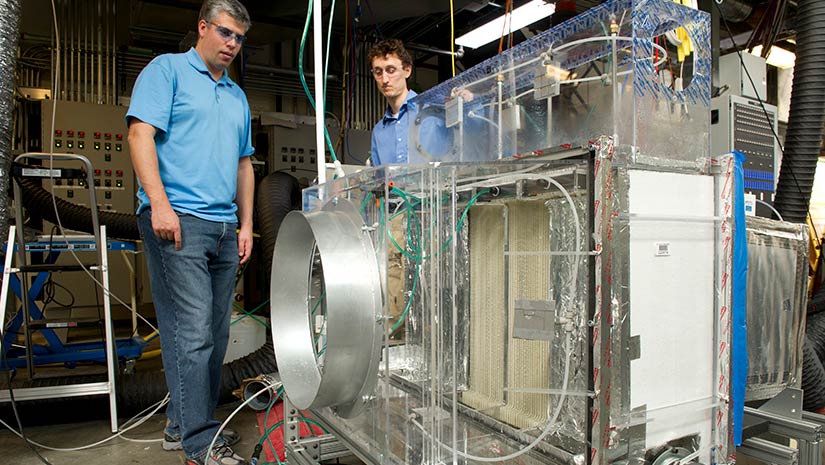Leveraging NREL All-Electric HVAC Technology, Blue Frontier Earns $20 Million Development Boost
Sustainable HVAC System Research Startup Receives $20 Million From Bill Gates-Funded Breakthrough Energy Ventures

Bolstered by technologies developed at the National Renewable Energy Laboratory (NREL), startup company Blue Frontier earned $20 million from the Bill Gates-funded Breakthrough Energy Ventures.
The pioneering technology is the first energy-storing, grid-interactive, all-electric air conditioner, with the potential to reduce CO2 emissions by up to 85% over traditional refrigerant systems. This funding makes the creation of a Blue Frontier heating, ventilation, and air conditioning (HVAC) pilot model possible within the next two years.
Eric Kozubal, senior mechanical engineer in NREL's Building Technologies and Science Center, said it has been a long walk to this achievement. He developed the "Desiccant-Enhanced Evaporative Air Conditioner" technology more than 10 years ago with NREL colleagues Ron Judkoff, Jason Woods, and Jay Burch. Their work went on to receive a prestigious R&D 100 Award as one of the most technologically significant inventions of 2012.
Funding was limited at first, Kozubal said, but the team knew they were on to something and joined forces with engineering entrepreneur Daniel Betts, who cofounded Blue Frontier. Betts is now Blue Frontier's CEO.
Kozubal said their goal was to merge several related NREL technologies into one package, with support from the U.S. Department of Energy's Technology Commercialization Fund, and produce a highly efficient, green HVAC system for the mass market. The first prototype was designed and tested over the past two years at NREL under the Wells Fargo Innovation Incubator (IN2) program, with Kozubal's team focusing on developing a commercial production-ready design.
"The electricity grid of the future is in desperate need of energy storage solutions like this," Kozubal said. "Blue Frontier and NREL are working to provide a more economical alternative for utilities."
The demand for heating and cooling is growing. July 2022 witnessed some of the hottest nighttime American temperatures ever recorded, creating more of a need for air conditioning in homes and businesses.
"HVAC systems are really energy intensive. When the weather gets hot and humid, the systems turn on and the grid must react to the load," Kozubal said. "Blue Frontier is a technology that can benefit anyone. The supply air is cool and drier than traditional AC units. This is unique in that it can control a building's temperature and humidity level much better."
Plugging Into the Power of NREL
Blue Frontier technology leverages two NREL innovations in its HVAC solution. The first is a cooling process using indirect evaporative air conditioning, which provides the refrigeration effect. The second is a concentrated salt solution (or desiccant), which controls humidity. The two processes are combined into a single conditioner system that cools and dehumidifies building spaces using minimal electricity to run fans and pumps.
Kozubal said the system's grid flexibility is derived from NREL's second innovation: an all-electric heat pump desiccant regenerator that reconcentrates the inexpensive desiccant and stores it in a compact tank during low-emission, low-cost electricity periods. Storing the desiccant enables up to 12 hours of low power conditioner operation when electric rates and carbon intensity are high.
"The electrification of this technology is a real breakthrough," Kozubal said. "The combination of efficient electrical regeneration combined with simple, inexpensive storage creates a system that saves up to 80% in energy costs while shifting the remaining energy to low-carbon sources."
In addition to Kozubal and Woods, NREL researchers involved include Greg Shoukas, Kyle Foster, Nelson James, and Kerry Rippy, as well as postdoctoral researchers Omar Labban, Ransisi Huang, and Yi Zeng. Other investors include 2150, VoLo Earth Ventures, and Modern Niagara.
Learn more about NREL's state-of-the-art buildings research facilities, capabilities, and partnership opportunities.
Last Updated May 28, 2025
